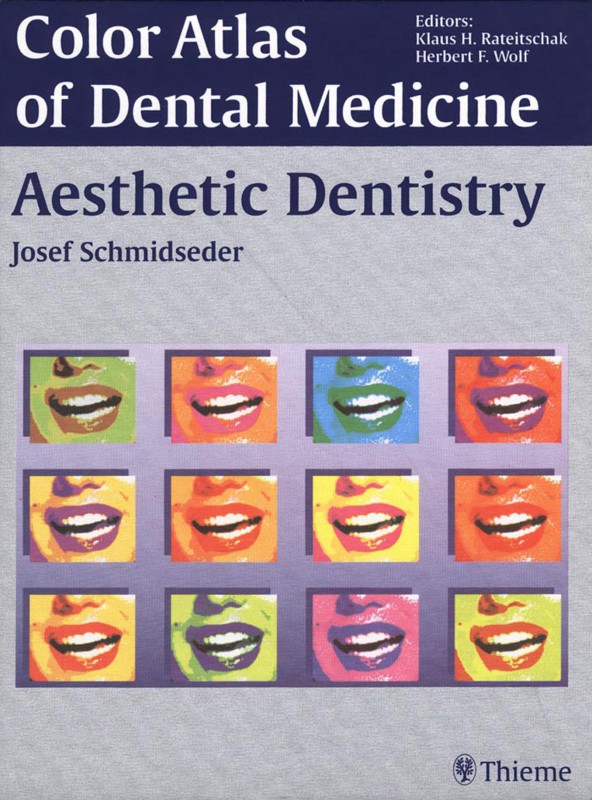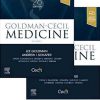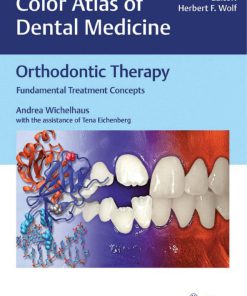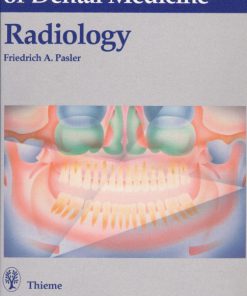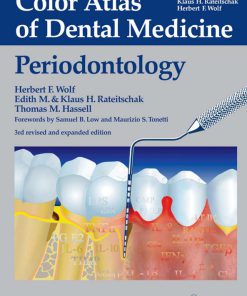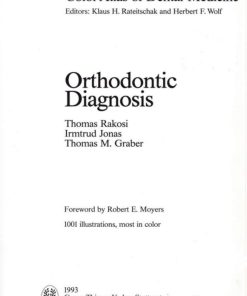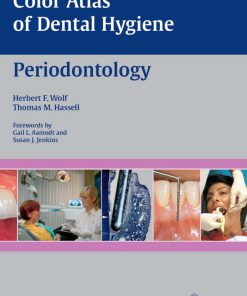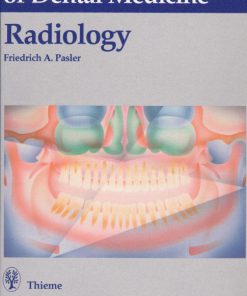Color atlas of Dental medicine Aesthetic Dentistry 1st Edition by Josef Schmidseder, Klaus Rateitschak, Herbert Wolf ISBN 9783131607515 3131607513
$50.00 Original price was: $50.00.$25.00Current price is: $25.00.
Authors:Schmidseder, Josef , Author sort:Schmidseder, Josef
Color atlas of Dental medicine Aesthetic Dentistry 1st Edition by Josef Schmidseder, Klaus Rateitschak, Herbert Wolf – Ebook PDF Instant Download/Delivery. 9783131607515 ,3131607513
Full download Color atlas of Dental medicine Aesthetic Dentistry 1st Edition after payment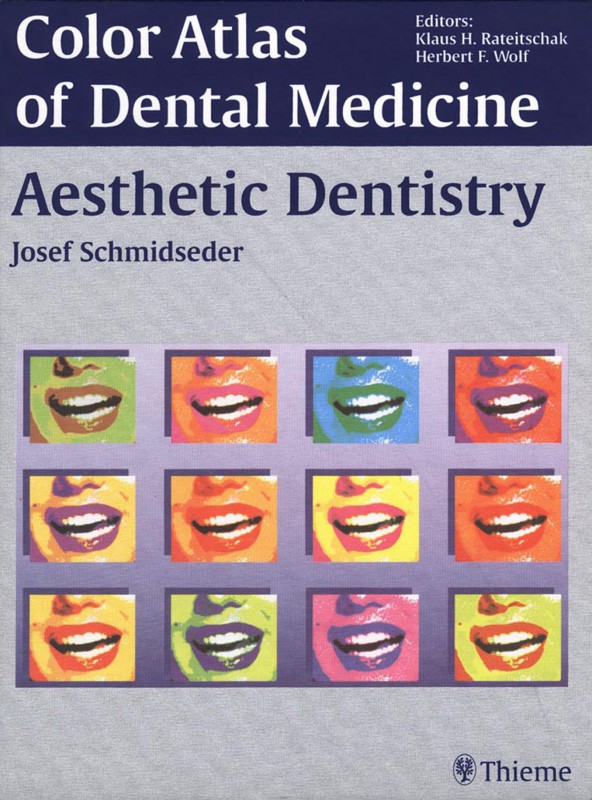
Product details:
ISBN 10: 3131607513
ISBN 13: 9783131607515
Author: Josef Schmidseder, Klaus Rateitschak, Herbert Wolf
In today’s modern dental practice, the patient’s role has changed—from petitioner seeking pain relief to client requesting a wide range of services, including improved looks. Often the patient will decide between amalgam, gold, composite or ceramics as the material of choice for a posterior tooth restoration, or have a say in the processing method used for its fabrication!
This lavishly illustrated new volume in the prestigious Color Atlas of Dental Medicine Series explores the full scope of today’s rapidly growing practice of aesthetic dentistry and its future evolution. You will find full coverage of the improved aesthetics and biocompatibility possible in new all-ceramic and metal-ceramic systems, plus details on in-lay, onlay, and veneer processing methods. And you will benefit from the informed discussion of each technique and system, complete with the advantages and disadvantages of each.
Special topics covered:
- Basic principles, indications, diagnostics, and treatment planning
- All background on composites-direct posterior restorations and composite inlays
- Aesthetics and function of direct anterior restorations
- The newest metal-ceramic and all-ceramic restorations, including clinical aspects of the all-ceramic crown and inlays
- Step-by-step bleaching techniques
- How to achieve maximum aesthetics with implants
Complete with a chapter on state-of-the-art computer assisted systems for use in restorative dentistry, and the impact of aesthetic techniques on every dental subspecialty, this book is informative and current. It recognizes that today’s practice has dramatically shifted from pain relief and functionality to a demand for excellent cosmetic results, and it will be a valued resource in every practitioner’s office. Stay up-to-date in a rapidly evolving field; order your copy today!
Color atlas of Dental medicine Aesthetic Dentistry 1st Edition Table of contents:
- Evolution of Artificial Tooth Replacements From an Aesthetic Point of View
- The Long Road to Individual, Functional Tooth Replacements
- Individual Tooth Replacements
- Metal Crowns
- Metal-Ceramics
- Biocompatibility and Aesthetics
- All Ceramic
- Additional AlI Ceramic Systems
- Conclusion and Outlook
- Basic Principles of Aesthetic Dentistry
- Caries as an Infectious Disease and How It Can Be Prevented
- Goal of Prevention
- Aesthetic Dentistry—A Treatment Concept
- The Necessity of Caring for Aesthetic Restorations
- Professional Tooth Cleaning in Patients with Aesthetic Restorations
- Manual Scling
- Scaling using Powered Instruments
- Air Polishing Devices
- Polishing Teeth
- Fluoride Treatment
- Home Care—Patients with Aesthetic Restorations
- Checklist—Dentist and Checklist—Patient
- Photography
- Why take Photos?
- Basics of Photography
- Camera Systems
- Instant Camera (Polaroid System)
- Technical Prerequisites for Digital Photography
- Digital Camera Systems—Criteria for Selection
- 35-mm Photo Systems and APS System
- Summary
- Intraoral Cameras
- Recommended Cameras
- Summary
- Using Intraoral Cameras
- Characteristics of Intraoral Camera Systems
- Cost-Benefit Considerations
- Using Videos for Patient Education
- Improved Vision During Treatment
- Treatment Using Indirect Vision
- Documentation
- Informing Family Members
- Insurance Companies
- Dental Picture Archives
- Patient Education
- How can the Intraoral Camera Be Used to Educate Patients?
- Use of Intraoral Cameras
- Bleaching
- History of Bleaching
- A Review of Bleaching Methods
- Side Efffects of the Bleaching Agent
- Which Discolorations Can Be Bleached?
- Bleaching Vital Teeth
- Home Bleaching
- Treatment Procedure
- Indications
- Contraindications
- Bleaching Agents
- Fabricating a Bleaching Tray
- In-Office Bleaching
- Possible Postoperative Complications
- Contraindications
- Treatment Procedure
- Indications
- Power Bleaching with Superoxol
- Possible Side Effects
- Patient Information for Home Bleaching
- Bleaching Novital Teeth
- Long Term Results
- How Long Do Bleached Teeth Remain White?
- Micro Abrasio Method
- Checklist—Bleaching
- Aesthetic Periodontal Surgery
- Gingival Recessions
- Classification
- Sliding Flaps
- Laterally Sliding Flap
- Surgical Procedure
- Causes of Possible Failure
- Coronally Repositioned Flap
- Surgical Procedure
- Free Gingival Grafts
- Surgical Augmentation Procedure
- Causes of Possible Failure
- Surgical Processes to Cover Recessions
- Connective Tissue Graft
- Surgical Procedures for Connective Tissue Grafts
- Surgical Procedures at the Donor Site (Palate)
- Grafting Procedure
- Combination Techniques
- Connective Tissue Graft Combined with a Coronally Repositioned Flap
- Connective Tissue Craft Combined with a Partial Thickness Double Pedicle Craft
- Guided Tissue Regeneration To Cover Recessions
- Surgical Procedure
- Corrections of the Alveolar Ridge
- Ridge Defects: Classification According to Seibert (1983)
- Surgical Procedure
- Exposing Impacted Teeth
- Red-White Aesthetics
- Surgical Crown Lengthening
- Surgical Procedure
- Composites—Background
- Matrix and Resin Systems
- Resin Systems
- Activator-Initiator Systems
- Inhibition Systems
- Aesthetic Qualities of Composites
- Coupling Agent
- Filler Particles
- Macrofilled Composites
- Micorfilled Composites
- Hybrid Composites
- Filler Share and Size
- Examples of Dental Composites
- Color and Color Determination
- Fishing and Polishing Composite Restorations
- Basic of Polymerization
- Durability of Composites
- Bonding
- Bonding: Resin Bonded to Enamel
- Structure of Enamel
- Checklist—Enamel Etching
- Bonding: Resin Bonded to Dentin
- Structure of Dentin
- Total Etch Technique
- History of Dentin Adhesives
- First- and Second-Generation Dentin Adhesives
- Third- and Fourth-Generation Dentin Adhesives
- The Path to Fourth-Generation Dentin Adhesives
- Current Abbreviations of Components and Active Substances of Bonding Systems
- Fifth-Generation Dentin Adhesives
- Clinical Considerations When Using Bonding Agents
- Factors Influencing Dentin Bonding
- Dentin Adhesives and Pulp
- Dentin Adhesives—The Ideal Therapy for Deep Caries Lesions
- Prevention of Root and Secondary Caries
- Desensitization of Dentin and Dental Necks
- Cements and Cementation
- Resin Cements
- Bonding Composite Inlays Using Resin Cements
- Bonding Ceramic Inlays Using Resin Cements
- Bonding Metal Surfaces Using Composite Cements
- Direct Anterior Restorations—Aesthetics and Function
- Indications for Composite Restorations
- Choosing a Composite
- Clinical Application of Composites
- Placing the Composite
- Class V Restorations
- Types of Class V Defects
- Procedure
- Class IV Restorations
- lncisal Elongation
- Diastema Closure
- Direct Composite Veneers
- Procedure
- Direct Posterior Restorations
- Checklist—Placing a Direct Class II Composite in the Posterior Region
- Advantages and Disadvantages of Composites
- Caries Detector for Tooth Conserving Preparations
- Indications For Posterior Composites
- Contraindications For Direct Composite Restorations in the Posterior Regions
- Composite Inlays
- Advantages and Disadvantages of Composite Inlays
- Composite Inlay Systems
- Diagnostics and Treatment Planning for Composite Inlays and Onlays
- Preparation of Composite Inlays and Onlays
- Making the Blocking Restoration, Materials, and Techniques
- Checklist—Inlay Preparation
- Making a Dental Impression
- Temporary Restoration
- Try-in of the lnlays
- Cementing the Inlays
- Trimming
- Immediate Inlays
- Direct Composite Inlays
- Metal-Ceramic and All-Ceramic Restorations
- Metal-Ceramic Restorations
- Clinical Success of Metal-Ceramics
- The Nature of Ceramic Tooth Restorations
- The Ceramic-Metal Connection
- Classification of Dental Ceramics
- Strength and Risk of Fracture of Ceramics
- Procedures For Strengthening Ceramics
- Minimizing Failures with Metal-Ceramic Restorations
- Minimizing Tensile Failures
- Minimizing the Number of Firing Cycles
- Glazing
- Polishing
- Laboratory Control of Cooling
- Foil and Electrochemically Plated Crowns
- All-Ceramic Crowns
- Alumina Ceramic Crowns (Vita Hi-Ceram, Vitadur Alpha)
- Dicor Glass Ceramic Crowns
- Leucite Reinforced Ceramics (Optec HSP)
- The Cerapress Technique
- Injection-Molded Glass Ceramic (IPS Empress)
- Optec OPC: Optimally Pressable Ceramic
- Procera AllCeram
- Glass Infiltrated Alumina Ceramic (In-Ceram)
- In-Ceram Spinell
- CAD/CAM Systems
- Summary
- All-Ceramic Systems—Clinical Aspects of the All-Ceramic Crown
- Indications and Contraindications
- Preparatory Steps
- Quality of Materials for All-Ceramic Systems
- Tasks for the Dentist
- Making an In-Ceram Spinell Crown
- Manufacturing a Cerapress Crown
- IPS Empress and OPC Technique
- Ceramic Inlays
- Overview
- Principles of Preparation
- Color Selection, Impression, and Temporary Restoration
- Ceramic Inlay Systems
- Sintered Ceramics
- Cerapress Technique
- IPS Empress and OPC Technique
- Try-in
- Fit
- Bonding Ceramic Inlays with Composite Cements
- Selecting a Suitable Cement
- Adhesive Bonding
- Checklist—Ceramic Inlays
- Veneers—From Planning to Recall
- The Advantages of Veneers
- Color and Aesthetics
- Durability and Tooth Conservation
- Function
- Strength
- Periodontium
- The Disadvantages of Veneers
- Cost
- Irreversibility
- Indications and Contraindications
- Diagnostics and Treatment Planning
- Initial Hygiene Session
- Preparation
- Impression and Temporary Measures
- Laboratory Technique
- Try-in and Color Correction
- Cerapress Technique
- Sinter Technique
- Adhesive Bonding
- Preparation of Tooth and Veneer
- Placing the Adhesive
- Placing the Veneer
- Several Veneers Placed in One Session
- Adjustments and Finishing
- Checklist—Veneers
- The Celay System
- Copy-Milling Procedure
- Technical Procedure
- Preparation and Fit
- Inlays and Onlays
- Crowns and Bridges
- Ceramic Materials
- Inlays, Onlays (Vita Celay Blank)
- Crowns, Bridges (Vita Celay Alumina Blank)
- Celay In-Ceram Spinell
- Cementation
- Advantages of the Celay System
- Summary
- CAD/CAM in Restorative Dentistry
- Digitizing Computer System
- Digital Data Recording and Computer-Aided Design
- Mechanical Processing of Ceramic Materials
- Possibilities and Limitations of Computer-Controlled
- Aesthetics in Implantology
- Osseointegration
- Treatment Planning
- Implantology and Aesthetics
- Implant-Supported Front Tooth Replacement
- Implant Positioning
- Surgical Procedure
- It’s the Patient’s Decision
- Cast Gold Restorations
- Gold Inlays
- Occlusal Inlays
- One- and Two-Surface Inlays
- Three-Surface Inlays (MOD)
- Gold Onlays
- Treating a Distal Defect on an Upper Canine
- Cementing Technique
- Checklist—Cast Gold Restorations
- Aesthetic Facial Surgery
- Abnormalities of the Chin
- Bilateral Horizontal Mandibular Hyperplasia
- Vertical Maxillary Hyperplasia
- Vertical Maxillary Hyperplasia, Mandibular Retrognathia, and Nasal Deformation
- Orthognathic Surgery
- Rhinoplasty
- Otoplasty
- Malar Augmentation
- Neck Liposuction
- Blepharoplasty
- The Future of Dentistry
- Developments in Dentistry
- Negative Future Trends in Dentistry
- Positive Future Trends in Dentistry
- Diagnosis and Treatment Planning
- Operative Dentistry
- Endodontics
- Periodontology
- Orthodontics
- Pedodontics
- Oral and Maxillofacial Surgery
- Prosthodontics
- Materials
- CAD/CAM
- Concepts
- Preventive Dentistry
- References
- Illustration Credits
- Index
People also search for Color atlas of Dental medicine Aesthetic Dentistry 1st Edition:
color atlas of oral and maxillofacial diseases
color atlas of oral diseases
color atlas of common oral diseases
color atlas of common oral diseases pdf

